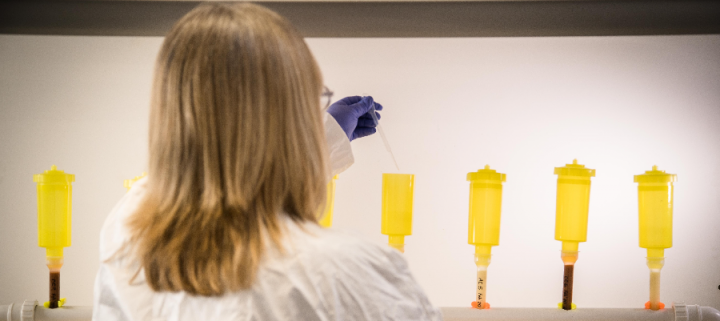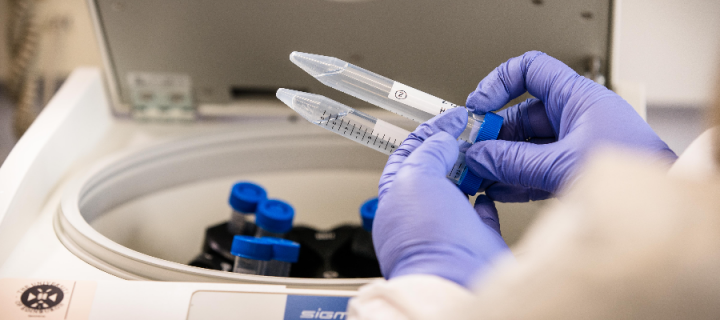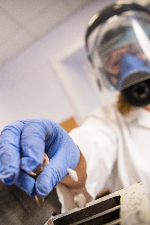Laboratories and equipment
Our facility has several purpose-built laboratories, which were refurbished in 2016. Find out more about our range of facilities and equipment.

Our facility can chemically extract cosmogenic isotopes from rock and sediment and prepare targets ready for measurement by Accelerator Mass Spectrometry (AMS) or Mass Spectrometry (MS).
We are able to support preparation work for all of the major cosmogenic isotopes including cosmogenic 10Be, 26Al, 36Cl, 21Ne, 3He and 14C.
What can be analysed?
Most nuclides are measured from within quartz minerals (10Be, 26Al, 21Ne, 14C). Therefore, any quartz-rich rock or sediment can be analysed. 3He is often measured within individual olivine crystals, while 36Cl can be measured in nearly any rock, making it particularly useful for carbonate rocks such as limestone.
We have preparation equipment that allows us to crush, sieve, and acid etch bulk rock to extract the mineral and size fraction required for analysis. We have clean laboratories and equipment that allow us to extract and purify the cosmogenic isotope of interest.
Capabilities
|
Rock crushing and sieving
|
Extraction of quartz from rock/sediment
|
Preparation of 10Be, 26Al and 36Cl targets
|
Facilities

The Cosmogenic Nuclide Laboratory has:
- Two clean rooms with filtered air and positive pressure
- Two fume cupboards with wash-down facilities rated for HF and HClO 4
- Four large volume ultrasonic baths for acid etching of quartz
- Two orbital shaker table
- Two centrifuge
- Two analytical balances
- Bench-top rock crusher
- Recirculating fume cupboard for use with cation and anion exchange columns
- Mineral separation lab with magnetic separator, sieve sets, and facilities for heavy mineral separations using non-toxic polylithium tungstate compounds
Our laboratories
Rock crushing and sieving laboratory

The rock crushing and sieving laboratory reduces rock fragments into sand-sized particles using a Fritsch Disk Mill.
The crushed rock is sieved to obtain the desired grain size for cosmogenic nuclide analysis or other purposes. We also have a Frantz magnetic separator that allows separation of ferromagnetic, paramagnetic and diamagnetic minerals, which is often used in the first stage of mineral isolation.
The lab contains a rotating sample splitter with glass recovery bottles, which is used to obtain equal and representative splits of sand samples necessary for 36Cl analysis.
Geochemistry laboratory - acid etching and isolation of minerals
The geochemistry laboratory is where we undertake acid etching and isolation of target minerals. Most of the work we do involves isolating quartz or feldspar from a variety of rock types. Samples undergo repeated etching in hexafluorosilicic acid H2[SiF6] on a shaker table to weaken silicate minerals.
Repeated etching by ultrasonic heating and agitation in a dilute aqueous HF and HNO3 solution is then used to preferentially dissolve non-quartz minerals and to partially dissolve quartz grains to remove meteoric 10Be. The end result is ultrapure (<200 ppm Al) quartz separates that are free from meteoric 10Be. The lab is fitted with 18.2 M-ohm deionised water, HF-rated fume cupboard with scrubber, ultrasonic baths, shaker tables, acid neutralisation facilities, scales, ovens and microscopes.
Clean laboratory for 10Be and 26Al preparation
The clean laboratory is where wet chemistry to isolate and purify 26Al and 10Be occurs. Samples are dissolved and passed through anion-exchange chromatography columns to remove Fe, and subsequently through cation exchange columns to remove Ti and B, and to split the Al and Be fractions. The Al and Be fractions are then precipitated as hydroxides and then oxidised in a furnace oven. The BeO and Al2O2 are mixed with Nb and Ag metals, respectively, and pressed in copper cathodes ready for AMS analysis. The lab is fitted with filtered air and ultrapure 18.2 M-ohm deionised water. It contains 2xHF and Perchloric acid-rated fume cupboards with scrubbers, a laminar flow fume cupboard, a centrifuge, scales, a furnace and a press.
Clean laboratory for 36Cl preparation and 10Be and 26Al preparation
This dedicated clean laboratory is where we undertake chemistry to isolate and purify 36Cl. We are set up to work with both carbonates and silicates. The samples are dissolved, and AgCl is precipitated with the addition of AgNO3. Sulphates are removed with the addition of Ba(NO3)2, and the final AgCl is purified and dried in an oven, then pressed with an AgBr substrate in a copper cathode ready for AMS analysis. The lab is fitted with red-lights, filtered air, and ultrapure 18.2 M-ohm deionised water. The lab contains an HF-rated fume cupboard, centrifuge, refrigerator, ovens, scales, and shaker tables.
Additional facilities
There are also various facilities available at our Kings Building's campus, which is about 2 miles from our laboratory.
These include:
- X-Ray Diffraction Facility
- X-Ray Fluoresence Facility
- NERC Ion Micro-Probe Facility
- Electron Probe Microanalysis Facility
- Scanning Electron Microscope Facility

